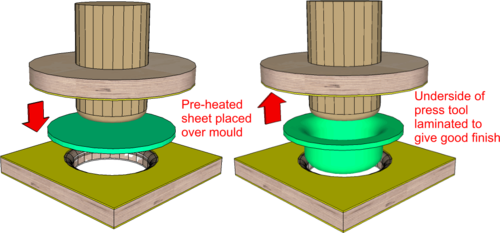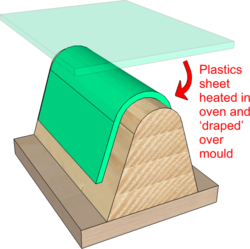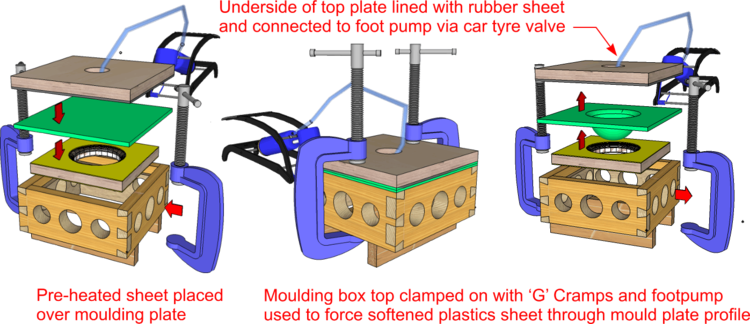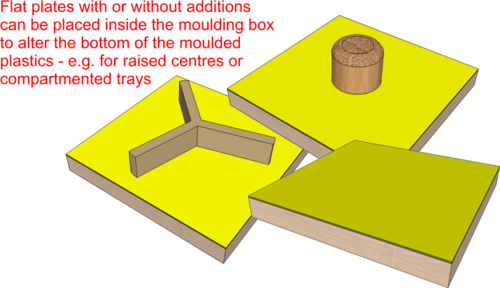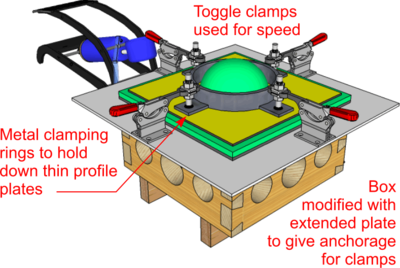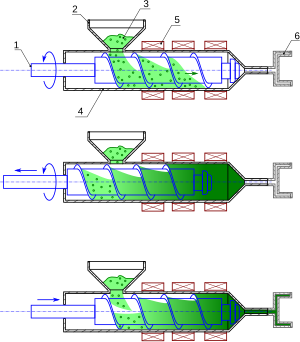Thermoforming Plastics: Difference between revisions
From DT Online
(Added Injection Moulding) |
mNo edit summary |
||
| Line 102: | Line 102: | ||
[[Category:Skills and Processes]] | [[Category:Skills and Processes]] | ||
[[Category:Working Plastics]] | |||
Revision as of 14:54, 11 November 2016
[[File:]]
Description
The term Thermoforming could be taken literally to include any process which uses heat to create a 3D form - Blacksmithing for example. Throughout DT Online the term is used to include all those processes which employ heat to mould certain plastics.
Synthetic* Plastics are chemically produced from oil and a wide, possibly infinite, variety is possible, but they all fit into one of two groupings:
- Thermoplastics - these can repeatedly be softened by heating and will return to a rigid state when cooled.
- this group includes: Acrylic, Polycarbonate (PC), Polyethylene, and Polypropylene.
- Thermosets - these are initially ‘cured’ (or set), often by mixing with a ‘hardener’ which creates a heat producing (Exothermic) chemical reaction and, once set cannot be softened again by further heating.
- this group includes: Polyester Resin, Epoxy Resin, Bakelite and Melamine.
*Note: Several natural materials may also be classified as Plastics. These include: Cellulose, Horn, Amber, and Shellac.
DT Online includes as Thermoforming all processes in which Thermoplastics are heated to create products with a particular emphasis on methods of moulding flat sheet materials.
Press Moulding
The sheet of Acrylic can be heated in an oven a between 275°F to 350°F (1350C to 1750C) then placed over a mould shape and pressed into it as shown - the two parts of the mould should be made with an allowance between them to accommodate the thickness of plastics sheet used.
Moulding plates can be Laminated with ‘Formica’ or similar and have well rounded corners to ensure the surface finish of the Acrylic is not unduly marked as pressure is applied.
Small pieces can be heated by careful use of a Hot Air Gun which is continuously moved over the surface until the Acrylic becomes suitably Malleable.
Drape Moulding
The sheet of Acrylic can be heated in an oven as above or small pieces heated with a Hot Air Gun.
Use oven gloves or similar when handling the hot Acrylic sheet and simply ‘drape’ it over a pre-prepared mould.
Minor adjustments can be made throughout using a Hot Air Gun to maintain moulding temperature and an extended moulding time can be achieved if the mould is first pre-heated.
Blow Moulding
Line Bending
As the name implies, a Strip Heater is a heating source which is shielded in such a way that only a narrow strip is exposed. In modern Strip Heaters the heat source is usually a length of Nichrome Wire but older machines may use a Infra-red Element.
A sheet of Acrylic, or similar, can be marked out using a Felt-Tip Pen and the bend or fold line laid across the heating strip untill it softens enough to bend easily by hand to the required angle. Materials thicker than 3mm should be turned regularly to avoid blistering caused by over-heating on one side.
Complex products may be modelled in card first to check which order to complete the bends or folds. Bending Jigs can be made to ensure folds are completed accurately and held in position until the material cools.
Vacuum Forming
Vacuum Forming is a process in which a sheet of relatively thin Thermoplastics (e.g. 1mm to 3mm thick) is heated, streched over a mould and then sucked down on to it by a vacuum.
The mould can be made by any material which will withstand the heat of the plastic and the force of the vacuum (e.g. wood or plaster). Moulds should be created such that any vertical surfaces have a slight taper or draft to ensure they can be withdrawn after moulding. They should be well finished and brushing on Talcum Powder or using Silicone Spray will aid their release (use only if the inside of the finished moulding is not to be painted - paint does not stick to silicone!). Moulds which have recesses should be made hollow with bleed holes drilled into them to help the vacuum draw the plastic in.
Injection Moulding
Injection Moulding is the most commonly used manufacturing process for the production of a great variety plastic products and components.
In industry, plastics granules are drawn into an Injection Moulder cylinder, or barrel, via a rotating screw to a point where they are heated and melted. The screw then operates as a piston and forces the melted plastic into a mould to create the products as shown:
- Reciprocating screw;
- Hopper;
- Granules;
- Barrel;
- Heaters;
- Mould.
As a consequence, most injection moulded products can be identified by the presence of a small ‘pip’ or sprue where the melted plastics entered the mould.

